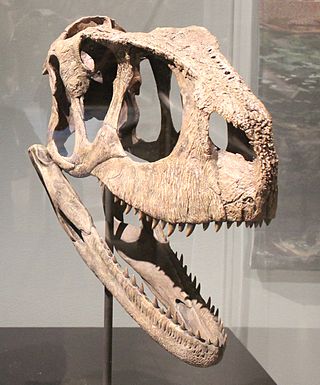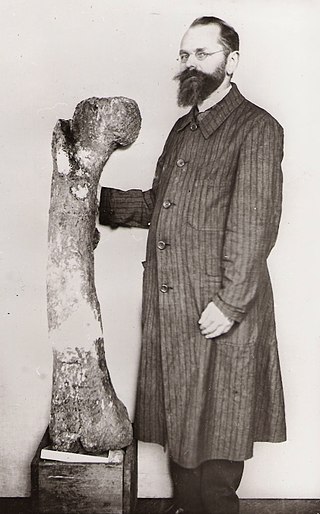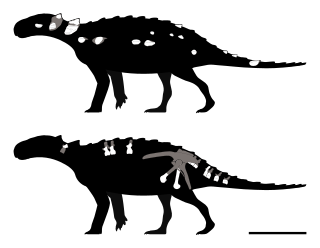
Rugops is a monospecific genus of basal abelisaurid theropod dinosaur from Niger that lived during the Late Cretaceous period in what is now the Echkar Formation. The type and only species, Rugops primus, is known only from a partial skull. It was named and described in 2004 by Paul Sereno, Jeffery Wilson and Jack Conrad. Rugops has an estimated length of 4.4–5.3 metres and weight of 410 kilograms. The top of its skull bears several pits which correlates with overlaying scale and the front of the snout would have had an armour-like dermis.

Bahariasaurus is an enigmatic genus of large theropod dinosaur. The genus is known to have included at least 1 species, Bahariasaurus ingens, which was found in North African rock layers dating to the Cenomanian and Turonian ages of the Late Cretaceous. The only fossils confidently assigned to Bahariasaurus were found in the Bahariya Formation of the Bahariya oasis in Egypt by Ernst Stromer but were destroyed during a World War II bombing raid with the same raid taking out the holotype of Spinosaurus and Aegyptosaurus among other animals found in the Bahariya Formation. While there have been more fossils assigned to the genus such as some from the Farak Formation of Niger, these remains are referred to with much less certainty. Bahariasaurus is, by most estimations, one of the largest theropods, approaching the height and length of other large bodied theropods such as Tyrannosaurus rex and the contemporaneous Carcharodontosaurus. The aforementioned estimations tend to put it at around 11–12.2 metres in length and 4-4.8 tonnes in overall weight.

Deltadromeus is a genus of theropod dinosaur from the Aoufous Formation of Morocco.

Megaraptor is a genus of large theropod dinosaur that lived in the ages of the Late Cretaceous. Its fossils have been discovered in the Patagonian Portezuelo Formation of Argentina, South America. Initially thought to have been a giant dromaeosaur-like coelurosaur, it was classified as a neovenatorid allosauroid in previous phylogenies, but more recent phylogeny and discoveries of related megaraptoran genera has placed it as either a basal tyrannosauroid or a basal coelurosaur with some studies still considering it a neovenatorid.
The Huincul Formation is a geologic formation of Late Cretaceous age of the Neuquén Basin that outcrops in the Mendoza, Río Negro and Neuquén Provinces of northern Patagonia, Argentina. It is the second formation in the Río Limay Subgroup, the oldest subgroup within the Neuquén Group. Formerly that subgroup was treated as a formation, and the Huincul Formation was known as the Huincul Member.

Orkoraptor is a genus of medium-sized megaraptoran theropod dinosaur from the late Cretaceous Period of Argentina. It is known from incomplete fossil remains including parts of the skull, teeth, tail vertebrae, and a partial tibia. The specialized teeth resemble those of some maniraptoriform theropods, namely the deinonychosaurs and compsognathids. This and other anatomical features led the authors who described it to suggest that it was a maniraptoran coelurosaur. However, subsequent studies found it to be a megaraptoran. Found in the Cerro Fortaleza Formation of Southern Patagonia, it is one of the southernmost carnivorous dinosaurs known from South America.

Bahariasauridae is a potential family of averostran theropods that might include a handful of African and South American genera, such as Aoniraptor, Bahariasaurus, Deltadromeus, and Gualicho. The placement of these theropods is controversial, with some studies placing them as basal ceratosaurs possibly related to Noasauridae, others classifying them as megaraptorans, basal neovenatorids, or basal coelurosaurs. There is also a possibility the group might not be monophyletic, as a monograph on the vertebrate diversity in the Kem Kem Beds published in 2020 found Bahariasaurus to be nomen dubium. In the same paper Deltadromeus is classified as an noasaurid, a result also recovered by some previous studies. A 2024 phylogenetic analysis found Aoniraptor, Bahariasaurus, Deltadromeus, and Gualicho to form a monophyletic clade as the sister taxon to Elaphrosaurus near the base of Ceratosauria.

Megaraptora is a clade of carnivorous theropod dinosaurs with controversial relationships to other tetanuran theropods. Its derived members, the Megaraptoridae are noted for their large hand claws and powerfully-built forelimbs, which are usually reduced in size in other large theropods.
Taurovenator is a medium-sized carcharodontosaurid theropod from the late Cretaceous of Argentina. Discovered by Matias Motta in 2005 and formally described in 2016, it is represented by an isolated right postorbital.
Gualicho is a genus of theropod dinosaur. The type species is Gualicho shinyae. It lived in what is now northern Patagonia, on what was then a South American island continent split off from the supercontinent Gondwana. The fossils were found in the Huincul Formation, dating to the late Cenomanian-early Turonian age of the upper Cretaceous Period, around 91 million years ago.
Tralkasaurus is a genus of abelisaurid dinosaur from the Huincul Formation from Río Negro Province in Argentina. The type and only species is Tralkasaurus cuyi, named in 2020 by Mauricio Cerroni and colleagues based on an incomplete skeleton. A medium-sized abelisaurid, Tralkasaurus exhibits a conflicting blend of characteristics found among the early-diverging abelisauroids with others that characterize the highly specialized clade Brachyrostra, and thus its position within the clade is poorly-resolved.

Overoraptor is an extinct genus of paravian theropod of uncertain affinities from the Late Cretaceous Huincul Formation of Argentinian Patagonia. The genus contains a single species, O. chimentoi, known from several bones of the hands, feet, and hips alongside some vertebrae.

Niebla is a genus of abelisaurid theropod dinosaur from the Late Cretaceous Period (Campanian-Maastrichtian) of Río Negro province, Argentina. The genus contains a single species, Niebla antiqua, and is known from a partial, non-articulated skeleton. The holotype, found in the Allen Formation, represents an adult individual.

Maip is a genus of large megaraptorid theropod dinosaur from the Late Cretaceous (Maastrichtian) Chorrillo Formation of Santa Cruz, Argentina. The genus contains a single species, M. macrothorax, known from an incomplete, disarticulated skeleton. Maip may represent the largest megaraptorid known from South America, and possibly the world.

Meraxes is a genus of large carcharodontosaurid theropod dinosaur from the Late Cretaceous Huincul Formation of Patagonia, Argentina. The genus contains a single species, Meraxes gigas.

Patagopelta is an extinct genus of ankylosaurian dinosaur from the Late Cretaceous Allen Formation of Argentina. The genus contains a single species, P. cristata, known from a partial skeleton. While originally described as a nodosaurine, later discoveries provided support for parankylosaurian affinities for the taxon. Patagopelta is a very small ankylosaur, comparable in size to the dwarf nodosaurid Struthiosaurus, about 2 m (6.6 ft) long.

Yatenavis is an extinct genus of enantiornithine bird from the Late Cretaceous Chorrillo Formation of Santa Cruz Province, Argentina. The genus contains a single species, Y. ieujensis, known from a partial humerus.

Chucarosaurus is an extinct genus of titanosaurian dinosaur from the Late Cretaceous Huincul Formation of Argentina. The genus contains a single species, C. diripienda, known from various limb and pelvic bones.
Sidersaura is an extinct genus of rebbachisaurid sauropod dinosaur from the Late Cretaceous Huincul Formation of Argentina. The genus contains a single species, S. marae, known from the remains of four individuals. Sidersaura represents one of the largest known rebbachisaurids.

Chakisaurus is an extinct genus of elasmarian ornithopod dinosaur from the Late Cretaceous Huincul Formation of Argentina. The genus contains a single species, C. nekul, known from multiple partial skeletons belonging to individuals of different ages. Chakisaurus represents the first ornithischian species to be named from the Huincul Formation.





























